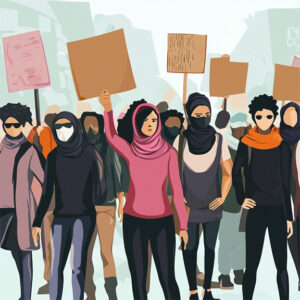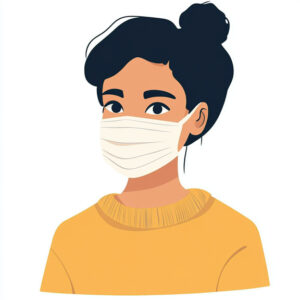In a clever bit of rhetoric, people who opposed mask and vaccine mandates during the last pandemic used pro-choice terms. For example, a person opposed to getting vaccinated might say “my body, my choice.” This phrase is, of course, a standard part of pro-choice language. While some who did this were no doubt engaged in bad faith rhetoric or trolling, the analogy between abortion rights and the right to refuse vaccination is worth considering.
An argument by analogy will typically have two premises and a conclusion. The first premise establishes the analogy by showing that the things (X and Y) in question are similar in certain respects (properties P, Q, R, etc.). The second premise establishes that X has an additional quality, Z. The conclusion asserts that Y has property or feature Z as well. The form of the argument looks like this:
Premise 1: X and Y have properties P, Q, R.
Premise 2: X has property Z.
Conclusion: Y has property Z.
X and Y are variables that stand for whatever is being compared, such as chimpanzees and humans or apples and oranges. P, Q, R, and are also variables, but they stand for properties or features that X and Y are known to possess, such as having a heart. Z is also a variable, and it stands for the property or feature that X is known to possess. The use of P, Q, and R is just for the sake of illustration-the things being compared might have more properties in common.
One simplified way to present the anti-vaccine (or pro-vaccine choice) analogy is as follows:
Premise 1: The right to choose an abortion is analogous to the right to choose to not be vaccinated.
Premise 2: The right to choose an abortion is supported by the left.
Conclusion: The right to choose to not be vaccinated should also be supported by the left.
While this analogy seems appealing to many anti-mask mandate folks, a key issue is whether it is a strong argument. The strength of an analogical argument depends on three factors. To the degree that an analogical argument meets these standards it is a strong argument.
First, the more properties X and Y have in common, the better the argument. This standard is based on the notion that the more two things are alike in other ways, the more likely it is that they will be alike in some other way. Second, the more relevant the shared properties are to property Z, the stronger the argument. A specific property, for example P, is relevant to property Z if the presence or absence of P affects the likelihood that Z will be present. Third, it must be determined whether X and Y have relevant dissimilarities as well as similarities. The more dissimilarities and the more relevant they are, the weaker the argument. So, is the analogy between the restrictive voter laws and mask mandates strong? To avoid begging the question by making a straw man, I will endeavor to make the best analogy I can—within the limits of truth.
The right to choose an abortion is often based on a principle of bodily autonomy; often expressed as “my body, my choice.” For the pro-choice, this principle warrants a person’s choice to have an abortion: it is their body, so it is their choice. While there is debate over the moral status of the aborted entity, an entity which might (or might not) be a person is killed by abortion. As such, the principle of bodily autonomy allows a person to kill another entity.
The right to forgo vaccination on the principle of bodily autonomy would seem to work in a similar manner. For those who are pro-choice about vaccines, this principle warrants a person’s choice to forgo vaccination: it is their body, so it is their choice. So far, so good. But, as with abortion, the choice does not just affect the person making the choice.
A person who forgoes vaccination willingly puts themselves and others in avoidable risk of infection and death. But, if a person can justly abort another entity as a matter of their choice, then one could infer that a person could thus put others at risk of illness and death as a matter of choice. But does the comparison hold here? I contend that because of critical differences, it does not.
 First, while an abortion kills an entity there is good faith moral debate about whether the entity is a person. In contrast, a person who did not get vaccinated during the pandemic put those who are indisputably people at risk and, in many cases, without their choice or consent. One can, of course, argue that the aborted entity is a person and start up the anti-abortion debate. But this would have an interesting consequence.
First, while an abortion kills an entity there is good faith moral debate about whether the entity is a person. In contrast, a person who did not get vaccinated during the pandemic put those who are indisputably people at risk and, in many cases, without their choice or consent. One can, of course, argue that the aborted entity is a person and start up the anti-abortion debate. But this would have an interesting consequence.
If it is argued that the aborted entity is a person (or otherwise has sufficient moral status) and thus its right to life overrides the person’s right to bodily autonomy, then the same reasoning would apply to the pro-vaccine choice argument. Their bodily autonomy does not give them the right to put others at risk. As such, a person who argues in good faith that being pro-choice about abortions is like being pro-choice about vaccines must be for both or opposed to both. So, anti-abortion folks can only use the pro-choice bodily autonomy argument for vaccine choice in bad faith (or from confusion). In contrast, a pro-choice person need not be pro-vaccine choice. They can accept that the aborted entity is not a person or has a lower moral status than the person while accepting the obvious fact that the people who were harmed by the unvaccinated are people.
Second, an abortion kills a single entity while forgoing vaccination during pandemic puts everyone the person contacts at risk of illness and even death. Since those at risk are indisputably people, forgoing vaccination in a pandemic is far worse than an abortion. One can, of course, get into a debate about assessing harm in terms of probabilities and other considerations. For example, a person who forgoes vaccination might not infect anyone and if they do, no one they infect might get ill, and if they do get ill, then they might not die. In contrast, an abortion always kills the aborted entity. This becomes a debate about the right to harm other entities and assessing harm. But, if someone argues that a person does not have the right to harm another entity based on bodily autonomy, then this would apply to both abortion and vaccination: there should be no choice in either case.
Third, there is a difference in the cost for not being able to make the choice. If a person cannot choose an abortion, they can face great economic and social hardships. Our society is unkind to women, and it is especially unkind to mothers who lack support and resources. In contrast, the COVID vaccines are incredibly safe. Much safer than giving birth in the United States. Once again, if someone accepts the pro-vaccine choice reasoning, then they would also need to accept the pro-choice reasoning in the context of abortion.
As such, the attempt to use pro-choice language and draw an analogy between reproductive rights and anti-vaccine rights fails logically. However, some might see it as having rhetorical value or as a bit of fun in trolling the libs with their own slogans.

 Because of the psychological power of rhetoric, words do matter. Words have both a denotation (the meaning) and a connotation (the emotions and associations invoked). Words that have the same denotation can have very different connotations. For example, “police officer” and “pig” (as slang) have the same denotation but different connotations. As would be expected, the ongoing fight over vaccines involves rhetoric. One interesting example of this was presented by Ben Irvine:
Because of the psychological power of rhetoric, words do matter. Words have both a denotation (the meaning) and a connotation (the emotions and associations invoked). Words that have the same denotation can have very different connotations. For example, “police officer” and “pig” (as slang) have the same denotation but different connotations. As would be expected, the ongoing fight over vaccines involves rhetoric. One interesting example of this was presented by Ben Irvine:  In the last pandemic Americans were caught up in a political battle over masks. Those who opposed mask mandates tended to be on the right; those who accepted mask mandates (and wearing masks) tended to be on the left. One interesting approach to the mask debate by some on the right was to draw an analogy between the mask mandate and the restrictive voting laws that the Republicans have passed. The gist is that if the left opposed the voting laws, then they should have opposed mask mandates. Before getting into the details of the argument, let us look at the general form of the analogical argument.
In the last pandemic Americans were caught up in a political battle over masks. Those who opposed mask mandates tended to be on the right; those who accepted mask mandates (and wearing masks) tended to be on the left. One interesting approach to the mask debate by some on the right was to draw an analogy between the mask mandate and the restrictive voting laws that the Republicans have passed. The gist is that if the left opposed the voting laws, then they should have opposed mask mandates. Before getting into the details of the argument, let us look at the general form of the analogical argument. While Republican politicians in my adopted state of Florida profess to love freedom, they have been busy passing laws to restrict freedom. During the last pandemic Governor DeSantis opposed mask mandates and vaccine passports on the professed grounds of fighting “medical authoritarianism.” He also engaged in the usual Republican attacks on cancel culture, claiming to be a supporter of free speech. However, the Governor and the Republican dominated state legislature banned ‘critical race theory’ from public schools, mandated a survey of the political beliefs of faculty and students, and engaged in book banning. On the face of it, the freedom loving Republicans appear to be waging war on freedom. One could spend hours presenting examples of the apparent inconsistencies between Republican value claims and their actions, but my focus here is on value vagueness.
While Republican politicians in my adopted state of Florida profess to love freedom, they have been busy passing laws to restrict freedom. During the last pandemic Governor DeSantis opposed mask mandates and vaccine passports on the professed grounds of fighting “medical authoritarianism.” He also engaged in the usual Republican attacks on cancel culture, claiming to be a supporter of free speech. However, the Governor and the Republican dominated state legislature banned ‘critical race theory’ from public schools, mandated a survey of the political beliefs of faculty and students, and engaged in book banning. On the face of it, the freedom loving Republicans appear to be waging war on freedom. One could spend hours presenting examples of the apparent inconsistencies between Republican value claims and their actions, but my focus here is on value vagueness. , and they have cast the woke elite as the generals of this opposing force. “Wokeness”, like “cancel culture” and “critical race theory”, is ill-defined and used as a vague catch-all for things the right does not like. In large part, the war on wokeness has been manufactured by the right’s elite. In part, the war arises from grievances of the base. There are even some non-imaginary conflicts in this war —at least on the part of the Americans that can be seen as blue-collar workers. I will be focusing on this and will try to define the groups and harms as clearly and honestly as possible.
, and they have cast the woke elite as the generals of this opposing force. “Wokeness”, like “cancel culture” and “critical race theory”, is ill-defined and used as a vague catch-all for things the right does not like. In large part, the war on wokeness has been manufactured by the right’s elite. In part, the war arises from grievances of the base. There are even some non-imaginary conflicts in this war —at least on the part of the Americans that can be seen as blue-collar workers. I will be focusing on this and will try to define the groups and harms as clearly and honestly as possible. When it comes to pollution, people respond with a cry of
When it comes to pollution, people respond with a cry of  While most states have hate crime statutes
While most states have hate crime statutes It might seem like woke madness to claim that medical devices can be biased
It might seem like woke madness to claim that medical devices can be biased A few years ago, PragerU tried to push back on Twitter (now X) against arguments by young Americans about racism. In general, getting involved in social media battles is a bad idea. To use an AD&D analogy, these fights are like punching green slime: the more you attack, the more you hurt yourself. And you end up covered in slime. It is usually best to avoid rather than engage.
A few years ago, PragerU tried to push back on Twitter (now X) against arguments by young Americans about racism. In general, getting involved in social media battles is a bad idea. To use an AD&D analogy, these fights are like punching green slime: the more you attack, the more you hurt yourself. And you end up covered in slime. It is usually best to avoid rather than engage.